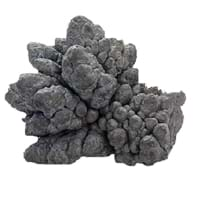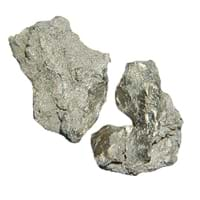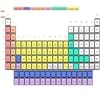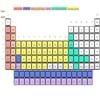Lead vs Zirconium
Periodic Table
Symbol
Pb
Zr
Group Number
14
4
4
14
Period Number
6
5
Block
p block
d block
Element Family
Post-Transition
Transition Metal
CAS Number
7439921
99+
7440677
23
Space Group Name
Fm_ 3m
P63/mmc
Space Group Number
225.00
2
194.00
5
Facts
Interesting Facts
- Galena mineral contains almost 87% of Lead metal in it, Galena is sulfide mineral.
- The best available source of Lead metal today is by recycling automobile batteries.
- Zirconium metal can resist to weak acids.
- Zirconium metal reacts with oxygen and nitrogen in the atmosphere.
Sources
Earth's crust, Found in Minerals, Mining, Ores of metals, Ores of Minerals
Found in Minerals, Mining, Ores of Minerals
History
Who Discovered
Unknown
Martin Heinrich Klaproth
Discovery
In Middle Easterns (7000 BCE)
In 1789
Abundance
Abundance In Universe
1 * 10-6 %
16
5 * 10-6 %
13
Abundance In Sun
~0.000001 %
18
~0.000004 %
16
Abundance In Meteorites
0.00 %
23
0.00 %
17
Abundance In Earth's Crust
0.00 %
26
0.01 %
14
Abundance In Oceans
0.00 %
22
0.00 %
23
Abundance In Humans
0.00 %
8
0.00 %
15
Uses
Uses & Benefits
- It is also used in insecticides, hair dyes and as an anti-knocking additive for petrol. But all these are banned by the government as Lead metal is known for detrimental to health.
- As this metal does not absorb neutrons; It is used in nuclear power stations.
- Its oxide is used in ultra strong ceramics. It is also used in manufacturing Crucibles.
Industrial Uses
Chemical Industry, Electrical Industry, Electronic Industry
Aerospace Industry, Ammunition Industry
Medical Uses
Surgical Instruments Manufacturing
NA
Other Uses
Alloys
Alloys, Nuclear Research, Research Purposes
Biological Properties
Toxicity
Toxic
NA
Present in Human Body
Yes
Yes
In Blood
0.21 Blood/mg dm-3
11
0.01 Blood/mg dm-3
21
In Bone
30.00 p.p.m.
10
0.10 p.p.m.
23
Physical Properties
Melting Point
327.50 °C
99+
1,852.00 °C
15
Boiling Point
1,740.00 °C
99+
4,377.00 °C
11
Appearance
Physical State
Solid
Solid
Color
Gray
Silvery White
Luster
Metallic
Lustrous
Hardness
Mohs Hardness
1.50
18
5.00
8
Brinell Hardness
38.00 MPa
99+
638.00 MPa
19
Vickers Hardness
Not Available
820.00 MPa
15
Speed of Sound
1,190.00 m/s
99+
3,800.00 m/s
20
Optical Properties
Allotropes
No
No
α Allotropes
Not Available
Not Available
β Allotropes
Not Available
Not Available
γ Allotropes
Not Available
Not Available
Chemical Properties
Chemical Formula
Pb
Zr
Isotopes
Known Isotopes
35
4
24
15
Electronegativity
Pauling Electronegativity
1.87
13
1.33
30
Sanderson Electronegativity
2.29
4
0.90
25
Allred Rochow Electronegativity
1.55
11
1.22
26
Mulliken-Jaffe Electronegativity
2.41
2
Not Available
Allen Electronegativity
1.85
8
1.32
34
Electropositivity
Pauling Electropositivity
1.67
99+
2.67
24
Ionization Energies
1st Energy Level
715.60 kJ/mol
31
640.10 kJ/mol
99+
2nd Energy Level
1,450.50 kJ/mol
99+
1,270.00 kJ/mol
99+
3rd Energy Level
3,081.50 kJ/mol
23
2,218.00 kJ/mol
99+
4th Energy Level
4,083.00 kJ/mol
35
3,313.00 kJ/mol
99+
5th Energy Level
6,640.00 kJ/mol
20
7,752.00 kJ/mol
10
6th Energy Level
Not Available
9,500.00 kJ/mol
15
Electrochemical Equivalent
3.87 g/amp-hr
9
0.85 g/amp-hr
99+
Electron Work Function
4.25 eV
21
4.05 eV
26
Other Chemical Properties
Anti Corrosion, Ionization, Radioactive Isotopes
Anti Corrosion, Flammable, Ionization, Radioactive Isotopes, Solubility
Atomic Properties
Atomic Number
82
34
40
99+
Electron Configuration
[Xe] 4f14 5d10 6s2 6p2
[Kr] 4d2 5s2
Crystal Structure
Face Centered Cubic (FCC)
Hexagonal Close Packed (HCP)
Crystal Lattice
FCC-Crystal-Structure-of-Lead.jpg#100
HCP-Crystal-Structure-of-Zirconium.jpg#100
Atom
Number of Protons
82
34
40
99+
Number of Neutrons
125
19
51
99+
Number of Electrons
82
34
40
99+
Radius of an Atom
Atomic Radius
175.00 pm
19
160.00 pm
27
Covalent Radius
146.00 pm
38
175.00 pm
23
Van der Waals Radius
202.00 pm
27
200.00 pm
28
Atomic Weight
207.20 amu
30
91.22 amu
99+
Atomic Volume
18.17 cm3/mol
27
14.10 cm3/mol
36
Adjacent Atomic Numbers
Valence Electron Potential
24.20 (-eV)
99+
80.00 (-eV)
18
Lattice Constant
495.08 pm
16
323.20 pm
99+
Lattice Angles
π/2, π/2, π/2
π/2, π/2, 2 π/3
Lattice C/A Ratio
Not Available
1.59
8
Mechanical Properties
Density
Density At Room Temperature
11.34 g/cm3
33
6.52 g/cm3
99+
Density When Liquid (at m.p.)
10.66 g/cm3
15
5.80 g/cm3
99+
Tensile Strength
12.00 MPa
20
330.00 MPa
12
Viscosity
Not Available
Not Available
Vapor Pressure
Vapor Pressure at 1000 K
1.64 (Pa)
7
Not Available
Vapor Pressure at 2000 K
Not Available
0.00 (Pa)
21
Elasticity properties
Shear Modulus
5.60 GPa
99+
33.00 GPa
20
Bulk Modulus
46.00 GPa
24
91.10 GPa
17
Young's Modulus
16.00 GPa
99+
88.00 GPa
22
Poisson Ratio
0.44
3
0.34
10
Other Mechanical Properties
Ductile, Malleable
Ductile, Malleable
Magnetic Properties
Magnetic Characteristics
Specific Gravity
11.35
25
6.51
99+
Magnetic Ordering
Diamagnetic
Paramagnetic
Electrical Properties
Electrical Property
Poor Conductor
Conductor
Resistivity
208.00 nΩ·m
16
421.00 nΩ·m
11
Electrical Conductivity
0.05 106/cm Ω
36
0.02 106/cm Ω
99+
Electron Affinity
35.10 kJ/mol
28
41.10 kJ/mol
27
Thermal Properties
Specific Heat
0.13 J/(kg K)
39
0.27 J/(kg K)
19
Molar Heat Capacity
26.65 J/mol·K
26
25.36 J/mol·K
99+
Thermal Conductivity
35.30 W/m·K
38
22.60 W/m·K
99+
Critical Temperature
Not Available
Not Available
Thermal Expansion
28.90 µm/(m·K)
13
5.70 µm/(m·K)
99+
Enthalpy
Enthalpy of Vaporization
179.40 kJ/mol
99+
581.60 kJ/mol
9
Enthalpy of Fusion
4.77 kJ/mol
99+
20.90 kJ/mol
11
Enthalpy of Atomization
194.60 kJ/mol
99+
598.00 kJ/mol
10
Standard Molar Entropy
64.80 J/mol.K
17
39.00 J/mol.K
39
|
||
|
||
|












